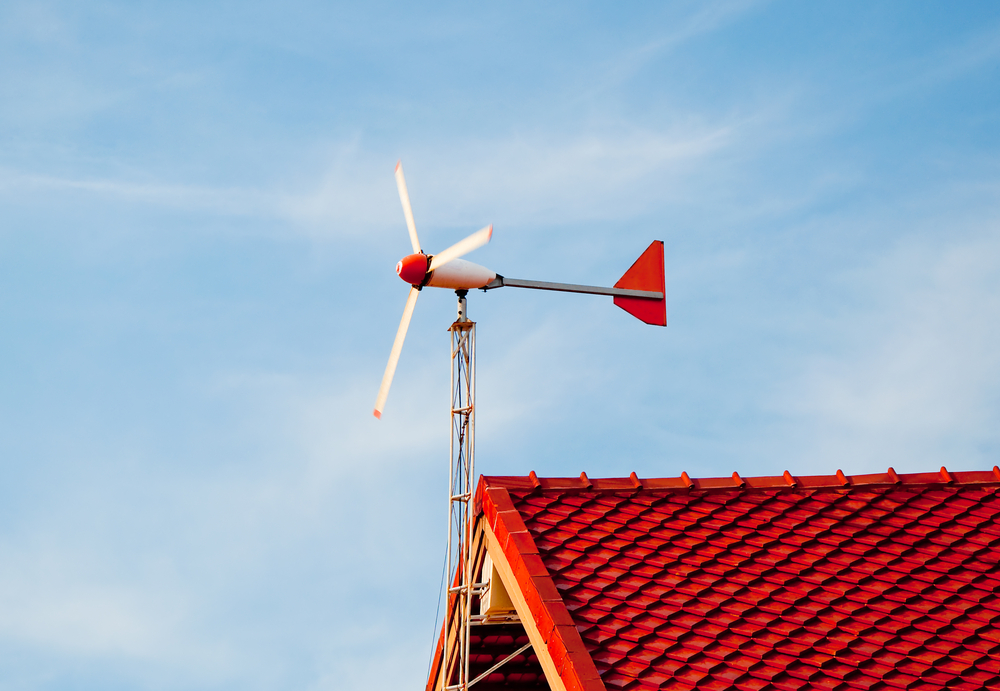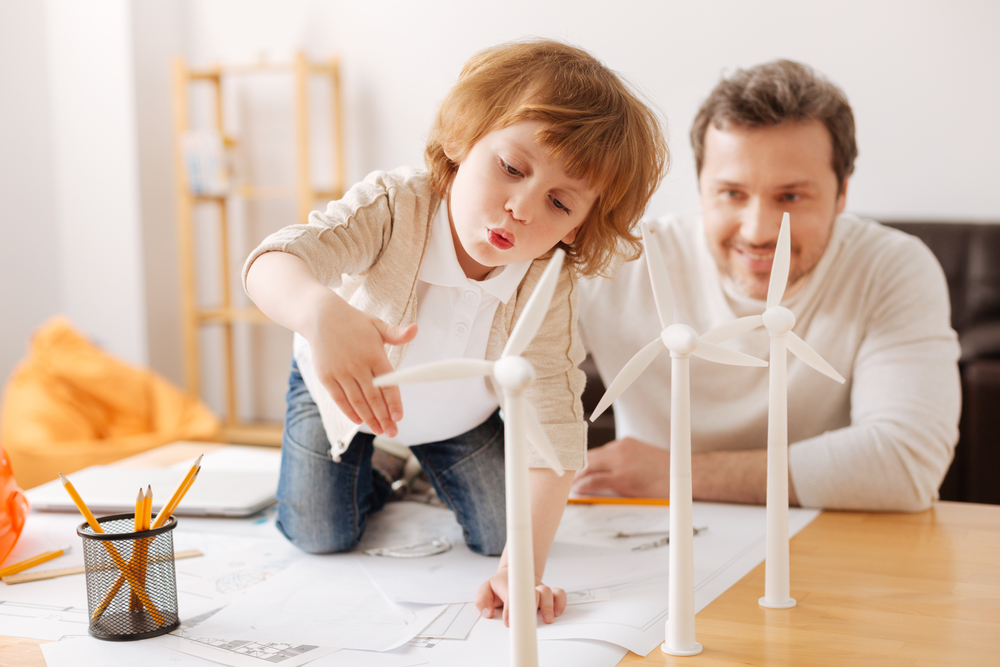Small Wind Turbines & Generators To Power Your Home

Industrial wind turbines are responsible for a remarkable 6.5% of America’s electricity. It’s no wonder why so many homeowners are looking for clever ways to capture the green benefits of wind energy. Small wind turbines take all of the natural magic of wind power and transform it into a residential-scale electricity machine. These scaled-down power-generation solutions are leading the way toward a more eco-conscious future, serving as an eco-friendly gateway to clean, cost-effective, renewable energy.
Even though wind turbines for homes are growing in popularity, they are one of the eco-friendly renewable energy sources seldom used. As a result, homeowners and people will have questions and concerns about price, efficiency, installation, and much more. We invite you to explore these questions as you read more below.
How do residential turbines work?
Small wind turbines, also known as residential wind turbines, have all the functionality of industrial-grade wind turbines. All wind turbines convert the kinetic energy created by the wind into mechanical power. Their propellers are architecturally engineered to capture the highest amount of energy from the wind. When the seized wind power is converted to electricity through the generator, it can provide power to your household lights, electric heating, appliances, and more. Depending on the size of your small wind turbine and your geographical location, you could generate enough power to eliminate your energy bill.
How can small wind turbines power my home?
Looking at small-scale wind turbines for your home, you may be skeptical about their efficiency and power delivery. But don’t discount these small wind turbines for your home. Each one could produce anywhere between 400 watts to 100 kilowatts of power. The range is wide because it is highly dependent on your geographical location. The higher and more constant the speed of the wind is, the more a small home turbine will generate.
Wind-generated electricity through a small home turbine can perfectly supplement your household's electricity needs. The amount of energy generated can power the following household items:
- Appliances (washer, dryer, dishwasher, etc.)
- Air conditioning and heating systems
- Water heaters
- Household lights
According to the U.S. Department of Energy, the best measure of wind turbine performance is the annual energy output. You may be unaware, but there is a distinct difference between power and energy. Power, measured in kilowatts (kW), is the rate at which electricity is consumed. Energy, measured in kilowatt-hours (kWh), is the total quantity consumed. When shopping for the perfect small wind turbine for your residence, find out the turbine’s estimated kWh/year to determine whether a wind turbine can produce enough electricity to meet your demands.
Why choose wind power?
There’s a reason why eco-conscious homeowners flock to green electricity alternatives to reduce their dependence on the grid and fossil fuels. The ever-imposing reality of climate change demands accurate, practical, renewable energy sources. Homeowners are welcoming renewable energy sources more openly and have begun to look at them as an investment in equity and the earth. Solar power has gained significant popularity on industrial and residential fronts, and winds energy trails closely behind in recent decades.
The history of humans harnessing wind power dates back as early as 5,000 BCE, windmills have come a long way since their 1850 invention—today stand over 200 feet tall and are capable of producing enough renewable energy to power the equivalent of 32 million American homes. Wind energy is growing so quickly across the globe. That the U.S. Department of Energy aims to replace 20% of the nation’s electricity with wind-produced power by 2030.

The potential for wind power has been made abundantly clear. Still, as an individual homeowner, it may be difficult to understand how to effectively use this power in your home with a small wind turbine. The benefits can be broken down into three key factors; wind power is 100% eco-friendly, free to generate, and 100% renewable.
As long as the Earth keeps spinning, disparate atmospheric pressures will continue to create wind, which can then be converted into electricity on a continuous loop. Homeowners are solely responsible for the installation costs of their small wind turbine—the energy generated after that comes at no cost. Wind power is entirely dependent on natural atmospheric phenomena. No harmful gasses, oils, or toxins are involved in the conversion process. Whether you’re looking to reduce your energy bills or your carbon footprint, choosing wind power allows you to capture both benefits in one fell swoop.
What types of residential turbines are there?
Small wind turbines exist in two dominant forms: rooftop and standalone towers. Among these two types, small residential turbines can be either horizontal-axis turbines or vertical-axis turbines.
Small residential horizontal-axis turbines
Horizontal-axis wind turbines are the most common type of small wind turbine. They typically feature three propeller blades oscillating upwind, forcing the blades into the wind to maximize capture capacity. Though they’re typically heavier than their vertical-axis siblings, horizontal-axis wind turbines are better engineered for higher energy generation.
Small residential vertical-axis turbines
Vertical-axis wind turbines use a rotational axis that is fixed perpendicular to the ground. These turbines are more typically reserved for residential applications but are becoming increasingly popular on an industrial scale. Vertical-axis wind turbines are designed to capture wind blowing at all angles, making them the more attractive option to those living in stormier climates.
What are the advantages of small wind turbines?
- Eco-friendly energy alternative
Unlike energy produced by fossil fuels, the energy produced by a small wind turbine is completely clean and eco-friendly. You won’t have to worry about polluting the environment with harmful emissions or dangerous long-term effects as you would with coal or oil-based energy generation. When you upgrade your home with a small wind turbine, you effectively reduce your dependence on conventional energy sources and join the eco-conscious homeowners carving out a greener tomorrow. - Renewability
Wind power is free to harness, but it’s also 100% renewable. Environmental air will always converge at different pressure rates, which is present worldwide. The source from where the wind is generated will always be available. You’ll never have to worry about a drained supply. - Financing availability
While one of the drawbacks to installing a residential wind turbine is the initial upfront costs, there are a number of specialized financing routes homeowners can use to reap the benefits of wind power. Property Assessed Clean Energy, also known as PACE financing is an easy installment-based plan for homeowners interested in financing their installation through special tax levies on their property.
What are the challenges of small wind turbines?
- Weather dependency
One of the most significant setbacks to wind power is that the energy generated depends entirely on geographical location and weather consistency. Wind energy can be unpredictable and inconsistent, making it nearly impossible to predict total monthly savings. In most geographical cases, the wind does not blow continuously, and the calculation for a payback period is harder to estimate. - Noise level
Wind turbines can emit sounds as loud as 50 to 60 decibels which can be incredibly noisy for otherwise tranquil neighborhoods. If you live in a rural area and benefit from being nearly neighborless, loud, whirring sounds would only be a nuisance to you. However, those in populated areas may not be as lucky. - Zoning regulations
Along with the struggle of dealing with considerably high noise level accommodation, installing a small wind turbine becomes even more complicated with local laws, HOAs, and zoning regulations that may forbid the installation altogether.
Suppose you’re unsure of your area’s zoning laws, regulations, and restrictions. In that case, you can contact your local building inspector, planning board, or board of supervisors to gain the knowledge you need for your project’s eligibility.
Consider A Small Wind Turbine For Your Home
Wind energy is on the rise and shows no signs of slowing. Homeowners looking to reduce their carbon footprint and slash their monthly energy bills will reap the benefits of both the instant their small wind turbine is installed. Although the upfront cost can be steep, it’s an intelligent way to take advantage of an infinitely abundant resource. To offset the upfront cost, remember that there are ways of financing renewable energy projects. Ygrene is a great partner that understands the financial challenges. Feel free to get started today and find out if you pre-qualify for the PACE program.




